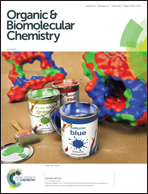Structure–functionality relationship and pharmacological profiles of Pseudomonas aeruginosa alkylquinolone quorum sensing modulators†
Abstract
An important paradigm in anti-infective research is the antivirulence concept. Pathoblockers are compounds which disarm bacteria of their arsenal of virulence factors. PqsR is a transcriptional regulator controlling the production of such factors in Pseudomonas aeruginosa, most prominently pyocyanin. In this work, a series of tool compounds based on the structure of the natural ligand 2-heptyl-4-quinolone (HHQ) were used for probing the structure–functionality relationship. Four different profiles are identified namely agonists, antagonists, inverse agonists and biphasic modulators. Molecular docking studies revealed that each class of the PqsR modulators showed distinctive interactions in the PqsR binding domain. It was found that the substituents in position 3 of the quinolone core act as a switch between the different profiles, according to their ability to donate or accept a hydrogen bond, or form a hydrophobic interaction. Finally, it was shown that only inverse agonists were able to strongly inhibit pyocyanin production.



 Please wait while we load your content...
Please wait while we load your content...